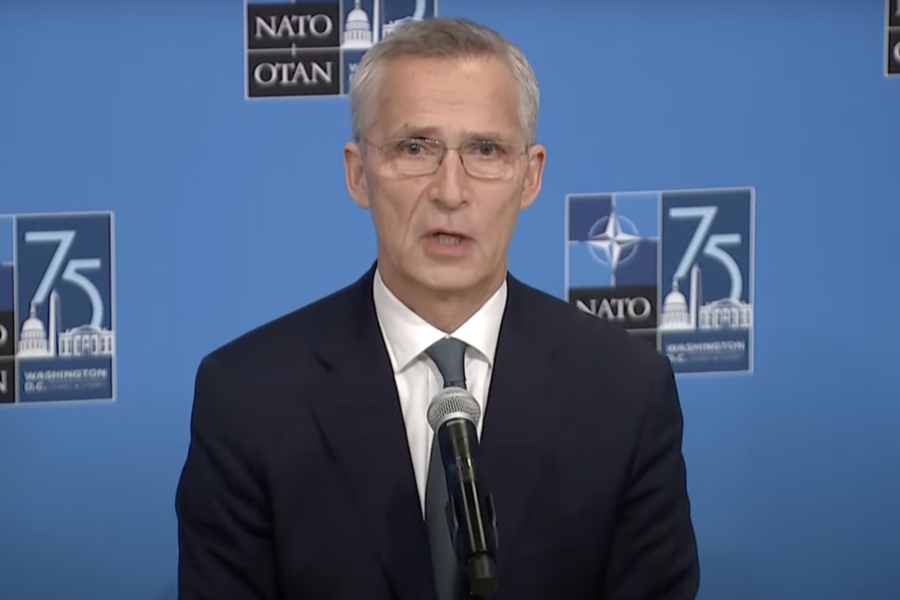NATO Secretary General Jens Stoltenberg unveiled new plans July 10 to enhance the alliance’s air and missile defense with combat-ready forces and an additional ballistic missile defense system.
“Today, we decided to adapt NATO’s command structure, improve our integrated air and missile defense systems, and to go further, to match our defense plans with the necessary capabilities,” Stoltenberg said at a press conference during the NATO summit in Washington D.C. “On deterrence and defense, we have deployed combat ready forces on NATO’s Eastern Flank, put in place the most comprehensive defense plan since the Cold War, and we now have over 500,000 forces at high readiness in the Alliance.”
The enhanced Integrated Air and Missile Defense system, or IAMD, will be based on a so-called “360-degree approach”—a concept that defense posture should align across the land, air, maritime, cyber, and space domains and against all other threats. The updated IAMD policy promises continued increases in the alliance’s “readiness, responsiveness, and integration through various initiatives.”
One initiative is the implementation of an IAMD rotational model across the Euro-Atlantic area, initially focusing on the Eastern Flank, a region encompassing member states like Lithuania, Poland, Romania, and Bulgaria. The U.S. Air Force permanently deployed aircraft in Poland for the first time last year, amid heightened regional tensions driven from Russia’s conflict with Ukraine.
“Allies also agreed to strengthen our air and missile defenses, including with the new Aegis Ashore Ballistic Missile Defense Base in Poland,” said Stoltenberg.
The deployment of the Aegis Ashore system in Poland is set to complement existing missile defense assets in Romania, Spain, and Turkey, strengthening NATO’s Ballistic Missile Defense system. The system, based on the shipboard Aegis Combat System, offers “dependable 360-degree protection,” military leaders have previously noted.
“Allies remain committed to the full development of NATO BMD, to pursue the Alliance’s collective defense and to provide full coverage and protection for all NATO European populations, territory, and forces against the increasing threat posed by the proliferation of ballistic missiles,” stated the Washington Summit Declaration from the meeting of the North Atlantic Council on July 10.
NATO’s new air and missile defense posture wouldn’t be possible without more and more members of the alliance meeting their pledge to spend 2 percent of their GDP on defense, Stoltenberg argued.
“All of this has been made possible by historic increases in defense investment across the Alliance,” said Stoltenberg. “When we made the pledge to invest 2 percent of GDP in defense, back in 2014 at the NATO summit, only three allies met the mark. Today, 23 allies are investing at least 2 percent of GDP in defense, a record-high number. This also brings the total defense spending of European Allies and Canada above the 2 percent target.”
NATO estimates indicate Poland remains the highest defense spender for the second consecutive year, allocating 4.1 percent of its GDP. Estonia and the U.S. are both projected at 3.4 percent.
Among other measures, the modernization of NATO’s collective defense system announced on July 10 includes the following:
- Increasing the frequency and scale of exercises to demonstrate readiness to defend and quickly support allies, including through Steadfast Defender 24, NATO’s largest military exercise in decades
- Urgently increasing capabilities under the NATO Defence Planning Process (NDPP), focusing on critical munitions and air and missile defense
- Integrating space into planning, exercises, and multi-domain operations, with a focus on enhancing NATO’s Space Operations Center
- Investing in Chemical, Biological, Radiological, and Nuclear (CBRN) defense capabilities to operate effectively in all environments
- Establishing a NATO presence in Finland and fully integrating Finland and Sweden into NATO plans, forces, and command structures to leverage their capabilities
